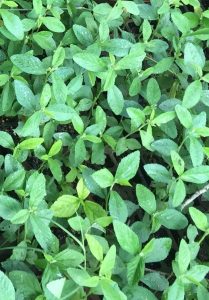Sweet Tea (Sida ulmifolia) provides your deer with high protein browse all summer long, increasing the productivity of your deer hunt by supplying a consistent nutrient source that will help does make milk and bucks grow antlers and frame. The live plugs we sell are large with a 5″ deep x 2″ wide root ball. Read below for more info.
| Box Qty. | Plant Qty. | Price |
|---|---|---|
| 1 | 90 | $180 |
| 5 | 450 | |
| 15 | 1350 |

Click here for our Sweet Tea Planting and Management Guide
* Sweet Tea (Sida ulmifolia) live plugs are for sale to end users only and are not for resale. Purchaser agrees that neither this plant material nor their progeny will be used by purchaser or any of his/her customers, clients, assignees or agents as nursery stock for the commercial production of, including but not limited to, seeds, plants, or tinctures, nor will it be subjected to any conventional breeding, biotechnology or genetic manipulation process.
*Important Note: Effective January 1, 2023, we are accepting custom grow orders only. Plants will ship in 3-4 months.
Shipping discounts on bulk orders available. Call 850-948-6294 or email Sales@SouthernHabitats.com
More Information on Sweet Tea (Sida ulmifolia)

In most cases as hunting season fades away, so does the available forage in our food plots. The bad thing about this is that spring and summer are when deer utilize large amounts of protein for does to produce milk, fawns and yearlings to grow frame and bucks to grow antlers. Additionally, when there is no food, deer stop using the plots. This hinders the effectiveness of our plots from a hunting standpoint. “Sweet Tea” routinely tests in the mid to high thirties in crude protein, higher than iron clay peas, clover, alfalfa and soybeans. Sweet Tea is also much higher in calcium and phosphorous content. These levels are very important for growing antlers and bone.
FAQ’s about Sweet Tea
What exactly is Sweet Tea?
Sweet Tea is a special selection of a perennial plant in the Mallow family named Sida that is highly attractive to deer. There are about a dozen species of Sida that occur in the Southeastern United States, some native and some non-native. There are numerous common names for different Sida species and many times the same common name is used for different ones, which leads to confusion. This is probably because there are several that look a lot alike. Sweet tea has been identified as Sida ulmifolia, which is a native plant of the Southeastern United States. Some of the common names used for this plant include Ironweed, Tea weed, Broomweed, Fanpetals and Wireweed. Tea weed is also used as a common name for Sida spinosa, which is an invasive plant in agriculture. Since it is native, Sida ulmifolia could never be considered an invasive plant. If it were going to become a problem plant, this would have happened many eons ago! This said the seed is easily transported by tires, which is why Sida is commonly found along roadsides and disturbed areas. Of all the Sida’s that were studied, ulmifolia stood out and seemed irresistible for deer.
What is different about Sweet Tea compared to regular commercial forages?
Sweet Tea is a native or wild plant. Currently on the market is a wide variety of food plot seed such as various clovers, cereal grains, brassicas and a number of other greens. They are mostly annuals but some are short-lived perennials and most are very high in nutrition and palatability. If you have good soil or have it amended properly and have a good system of getting these crops planted and growing successfully every year then you are lucky. We are not trying to discourage anyone from using these products. We use them too. We just want to help people recognize that there are perennial native plants that are much more forgiving about soil quality, pH and low rainfall. In fact they thrive in that environment. That is their “briar-patch”! It’s all about choosing the right ones. These plants keep making high-protein browse throughout the growing season, whether or not you have success with your annual food plot planting efforts. Hands down, Sweet Tea is the best one of all. If you don’t mind doing a little experimentation to determine where it performs best on your specific site you will be rewarded in a big way.
There is a huge amount of variability in wild plants from varying germination times (seed dormancy) to varying growth rates when subjected to different soils, temperatures, day lengths, etc. Virtually all of the variability has been bred out of commercial cultivars. This was done in order for the crop to be uniform for a more efficient harvest. The good thing about variability is that there is protection built into wild plants against untimely extreme weather events such as floods, droughts or freezes. Since there are always plants at all growth stages within the stand, including seeds in the soil beneath, the stand has a much better chance of persisting over the long term. Keep this in mind when you are getting your stand of Sweet Tea started and don’t compare it to planting something like peas or oats. You are establishing a stand not a crop. Once your stand is established in a good area it will be there every year. Then no matter if you have had time or the right weather to plant any other summer forage, Sweet Tea will be providing your deer with high protein browse all summer long. This will enhance the productivity of your deer hunt in two ways: The first is by providing a consistent nutrient source that will help does make milk and bucks grow antlers and frame. Secondly, when deer are accustomed to the plot being a reliable source of food they will be more likely to use the plots in hunting season. Be sure to inquire about our bare root switchgrass to create channeling and perimeter screens which has proven to be very effective in getting mature bucks out into the plot during daylight hours.
